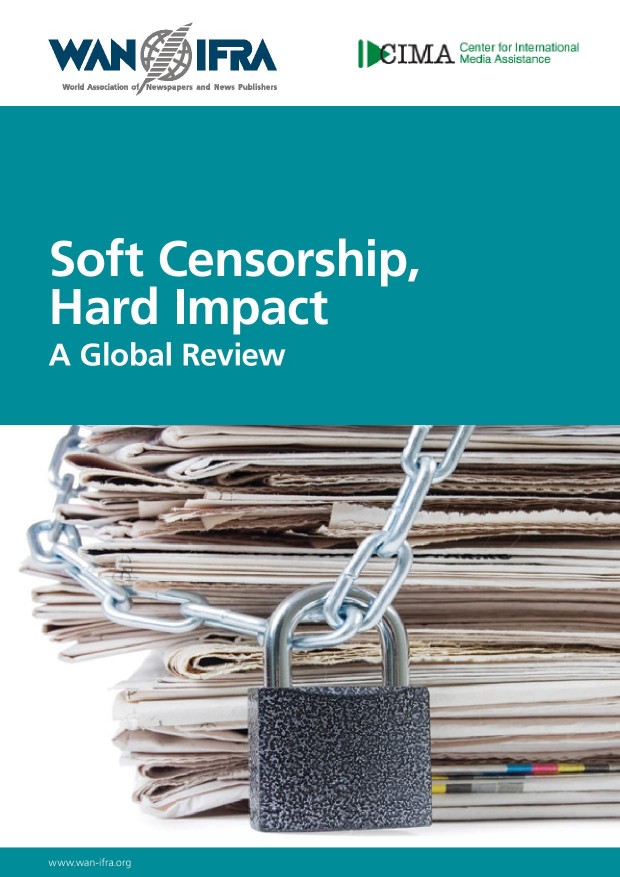Guest post by CIMA editorial consultant Thomas R. Lansner, writer/editor of Soft Censorship, Hard Impact.
Writing about “soft censorship” can be hard.
Hard because the definition and even the concept is relatively new and still open to debate.
Hard too because soft censorship is by intent elusive and amorphous–and mostly described anecdotally.
And hard because acts of “hard censorship”–assaulting journalists, shuttering news offices, smashing broadcast equipment, etc.–garner far greater attention for their immediate and sometimes terrible costs and are straightforwardly reportable as dramatic and all-too-familiar events.
Unlike direct attacks on media, soft censorship often arises from a complex and indirect process. Soft Censorship, Hard Impact, the report released this week by CIMA and WAN-IFRA, focuses primarily on financial aspects of official soft censorship. It offers summaries of in-depth investigations in Hungary, Malaysia, Mexico, and Serbia, and examples from 30 countries. These include government efforts to influence news coverage through biased, allocation or withholding of media subsidies, advertising, and other financial aid. They can also involve abuse of regulatory powers, and use of “paid news”–direct payments for favorable coverage–or outright bribery.
 Beyond the scope of Soft Censorship, Hard Impact and its associated country reports are myriad forms of unofficial indirect censorship promoted or imposed by a range of non-state actors that may affect media content. These encompass pressures from private advertisers or financiers, as well as self-censorship enforced by media owners. Some might have no directly financial bases, rising from cultural, religious, or other social norms and traditions or simple adherence to the societal narratives that influence institutional and individual reporting.
Beyond the scope of Soft Censorship, Hard Impact and its associated country reports are myriad forms of unofficial indirect censorship promoted or imposed by a range of non-state actors that may affect media content. These encompass pressures from private advertisers or financiers, as well as self-censorship enforced by media owners. Some might have no directly financial bases, rising from cultural, religious, or other social norms and traditions or simple adherence to the societal narratives that influence institutional and individual reporting.
A 2005 paper by the Open Society Justice Initiative, a partner in this research, described three main forms of official soft censorship: abuse of public funds and monopolies, abuse of regulatory and inspection powers, and extra-legal pressures that “combine a semblance of legality with clearly unlawful methods…”
Soft censorship can prove even more insidious than blatant media repression, yet it is often difficult to perceive. The public that is being denied accurate and impartial information is unlikely to be aware of its existence. Even within the relatively narrow definition of official financial pressures, soft censorship is a pervasive and pernicious threat to media freedom and the democratic processes that independent media are meant to facilitate.
Exposing soft censorship falls naturally into the mission and interests of both CIMA and WAN-IFRA. Part of CIMA’s mission is to highlight “the indispensable role media play in the creation and development of sustainable democracies.” A 2009 CIMA report was among the first efforts to assess soft censorship as a global phenomenon. WAN-IFRA seeks “to be the indispensable partner of newspapers and the entire news publishing industry worldwide… in the defence and promotion of press freedom, quality journalism and editorial integrity and the development of prosperous businesses and technology.”
Working with local groups that researched country reports [Mertek Media Monitor, the Balkan Investigative Reporting Network, FUNDAR, Article 19 Mexico and Central America] was essential to generating pertinent recommendations based on highly credible quantitative and qualitative information. Focusing on official soft censorship ensures that this research can be more easily turned into efforts for reform. It emphasizes the actions of governments, which use public funds and should be accountable to that public, and are also at least nominally constrained by a range of domestic and international laws.
The late Cameroonian journalist and media freedom advocate Pius Njawe described soft censorship as “sophisticated repression [that] requires a sophisticated response.” Foremost among the recommendations in Soft Censorship, Hard Impact is a demand for transparency in all allocation of official advertising, as well as all government subsidies to media. Exposing official malfeasance provides media freedom groups the bases for targeted advocacy and legal challenges against various techniques of soft censorship.
************
Soft Censorship, Hard Impact: A Global Review, is a new report released this week by CIMA and WAN-IFRA. The report is part of continuing series of country analyses through which local research partners have so far detailed soft censorship in Hungary, Mexico, and Serbia. A report on Malaysia will be published soon.

Comments (0)